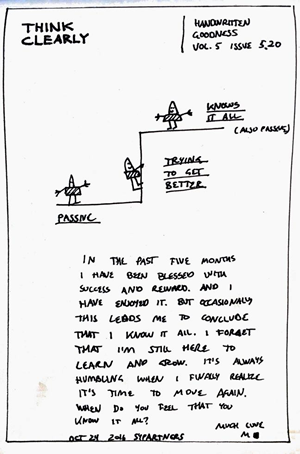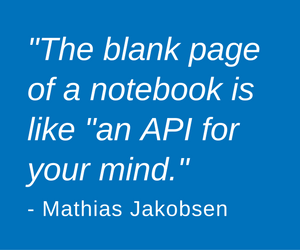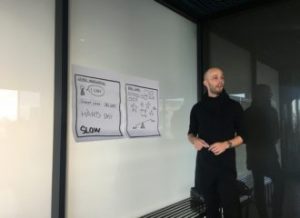Earlier this year, I discovered Mathias Jakobsen, his Think Clearly website and his clever Clarity Cards deck. Since then, I’ve become quite intrigued by his unique approach to visual thinking – which includes a visual newsletter where he shares a sketch and a thinking concept each week, and a series of visual thinking workshops, which he has scheduled all over the world.
 Mathias also counts David Gray, the founder of XPLANE and author of several visual thinking books, as a mentor. In fact, it was with Dave’s encouragement that Mathias produced a set of Clarity Cards – which help people process information and experiences, and reach clarity in their work and lives (see my interview with Mathias about this thinking aid).
Mathias also counts David Gray, the founder of XPLANE and author of several visual thinking books, as a mentor. In fact, it was with Dave’s encouragement that Mathias produced a set of Clarity Cards – which help people process information and experiences, and reach clarity in their work and lives (see my interview with Mathias about this thinking aid).
Frey: You’re a big believer in visual thinking. In your opinion, what benefits and advantages does it provide?
Jakobesen: In written text you can either be brief or have a lot of texture and detail. But if you want to have both you need to separate the two: a brief summary in the beginning or end and then the bulk of text with details. The big picture and the details. As a reader you can of course read both but not at the same time. The same goes for spoken language.
However, visual language has a different way of operating. When information is laid out visually for example on a big wall poster, you can often integrate the details into a bigger picture, in a way that allows the reader to seamlessly swap between the macro and micro view. When looking at the whole, the eye is still able to perceive visual clues about the details. And when shifting focus to the details, the peripheral vision still allows the eye to absorb the details in their context.
Frey: In your opinion, why are so many people dismissive of visual thinking? They prefer to process information in linear formats – words, sentences, paragraphs, etc.
Jakobsen: Let’s be clear: visual thinking is good for many things but not for everything. Visual thinking can help untangle complexity and allows you to see the structure behind the drama. But for some situations the whole purpose is drama. Think about Game Of Thrones or any other exciting and dramatic tv show: we could make a very clear visual map of all the events and relationships in the show. But that doesn’t make for exciting watching. The thrill is to discover the intricate relationships.
So: right tool for the right job.
That said, I think many people are scared of visual thinking because they (wrongly) believe that you need to be an artist. Perhaps they have been told as a child that their drawings were not good. Whatever the reason, it’s intimidating to try to draw.
 Frey: How did you come up with the idea of a visual newsletter?
Frey: How did you come up with the idea of a visual newsletter?
Jakobsen: I didn’t. People around me kept asking me to do it, and I said I didn’t want to make another marketing-self-promotional newsletter. I hate those. So I pushed it off every time. Until a long term client helped me see that it didn’t have to be promotional, and that I could just write it by hand and scan it instead of working with a computer. He said he would value it. That convinced me to begin. The first few issues were sent to 20-30 people.
Frey: You open each drawing with the greeting, “Hello Amazing!” What does this say about how you view the readers of your newsletter, and their potential to think visually and gain some amazing insights?
Jakobsen: I feel like this is a bit like asking a poet to analyze his own poems 🙂 I’m not fully sure. It was just sort of there one day and I liked it and kept doing it. I guess I like that it’s so optimistic and assuming the best in everyone.
Frey: Are your personal journal entries frequently written or visual, or a combination of the two? How does it help you process and crystallize your thinking?
Jakobsen: My own journal is very much like the newsletter: a mix. There is lots of text. And some simple drawings.
Occasionally a page is mainly a sketch or diagram. For me it’s like therapy where I’m both the therapist and client. I practice my craft as a facilitator and I experience the frustration that everyone goes through when trying to manifest in the world something that hasn’t existed before.
Frey: Where do you get inspired to create your drawings? Current experiences or accumulated knowledge – or both?
Jakobsen: A lot of it is current experiences and challenges that I am going through right now, or perhaps just got through. So it’s often pretty raw and close to me. It can also be challenges that people that are close to me are experiencing.
Frey: Who inspires you? I know that Dave Gray from XPLANE is a friend and mentor. Who else do you look to for inspiration?
Jakobsen: I am inspired by people where their work, their being and everything they say all seems to be in alignment. Dave is one of these people who is not defined by any box – is he an artist? an author? a successful businessman? To is all of them and none of them. He writes books the way he runs his business which is also the way he makes art. It’s all part of the same fabric. It’s all creation.
My other heroes include Jorgen Leth, a danish poet, filmmaker, author, cycling connoisseur. He is incredible. Sir David Attenborough is another, where his passion, voice, work and entire being is just one. His Planet Earth voice over is fine art. Leonard Cohen, Beyonce, and many other great performers, who show up again and again with grace, humility and utmost generosity, are also big inspirations for me.
Frey: In an interview with Karolina Andersson on her Medium blog, you mention the concept of “visually facilitating your own mind.” What do you mean by that? How do you do it?
Jakobsen: That’s what I also alluded to above: it’s like therapy for and with myself. The page becomes a third object, that allows me to take turns as facilitator and subject. I ask a question, write it down, switch roles and read the question. Then I answer, write down the answer or draw it out, and then switch back. It’s pretty seamless.
Frey: In that same interview, you also talk about using a blank page of a notebook as “an API for your mind.” That’s a fascinating concept. What do you mean by it? In what ways is visual thinking like an API? (translating ideas from your mind onto paper? Or is it deeper than that?)
 Jakobsen: The point of this is that most people don’t feel that they can control their thoughts. I certainly can’t. Thoughts just run around my head. But I can control my hands. And I can control my eyes.
Jakobsen: The point of this is that most people don’t feel that they can control their thoughts. I certainly can’t. Thoughts just run around my head. But I can control my hands. And I can control my eyes.
This means that if I can make the cycle of thoughts that run through my head, take a detour through my hands, onto the page and back into my mind through my eyes, it means that now I have a link in the chain where I have control. So I can hold my attention to a specific challenge for longer, by letting my eyes stare at the question or prompt.
And if my thoughts are looping in some unproductive negative pattern I can map it out on the page and then make a different choice. Break the cycle.
Frey: Tell me about the visual thinking workshops you’ve been conducting around the world. What was the genesis of that idea?
 Jakobsen: The idea was simply to take what I have learned in the past 4-5 years facilitating leaders all over the world through visuals and self reflection, and package it into a portable format that I could take around the world. It’s been amazing.
Jakobsen: The idea was simply to take what I have learned in the past 4-5 years facilitating leaders all over the world through visuals and self reflection, and package it into a portable format that I could take around the world. It’s been amazing.
I spoke to renowned sketchnoter Mike Rohde about this at length here.
Frey: What do workshop participants come away with that they can use in their day-to-day work?
Jakobsen: I think the biggest take-away is that you just need to begin. It will never be perfect the first time. So just do a quicker first version. Show it to others. I think most people see how it works with pen and paper, but this really applies to anything in work. They call it “iterative” with a fancy word, but that’s less important. Yo can read a lot of books about being iterative but it’s only when you practice it in small and big ways that it really makes a difference. I also think there is a huge amount of vulnerability in the course and I think this is another powerful tool people are taking back to their work.
Frey: Do you plan to offer your visual thinking workshop as an e-learning program to enable it to reach more people?
Jakobsen: Obviously, you can only travel so much, especially with a newborn at home.
I actually already have a shorter online version on my site. It’s not as deep, because the depth doesn’t come from what I say but from the interactions between the participants in the room. This part is harder to create online.
Frey: What’s next for you? What cool projects are on the horizon for you?
Jakobsen: I’m working on a few things. On the most overall level I am seeking to join up with an existing organization and be part of something bigger than myself. I am currently working part time at SYPartners in NYC and really liking it, and I find that my personal brand is very much aligned with our vision here, so it feels natural.
On my own I am looking into doing more global keynote talks. I have a new talk about digital transformation and leading into the unknown. I did it in Denmark this past weekend and two weeks ago I did a version of it for some executives at KPMG. It’s a natural extension of the work I was doing at Hyper Island last year, and it’s just still so needed. We need to come to terms with this whole internet, and to understand more deeply how it is upending everything from business and products to parenting and food.


Leave a Reply